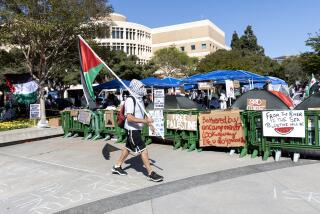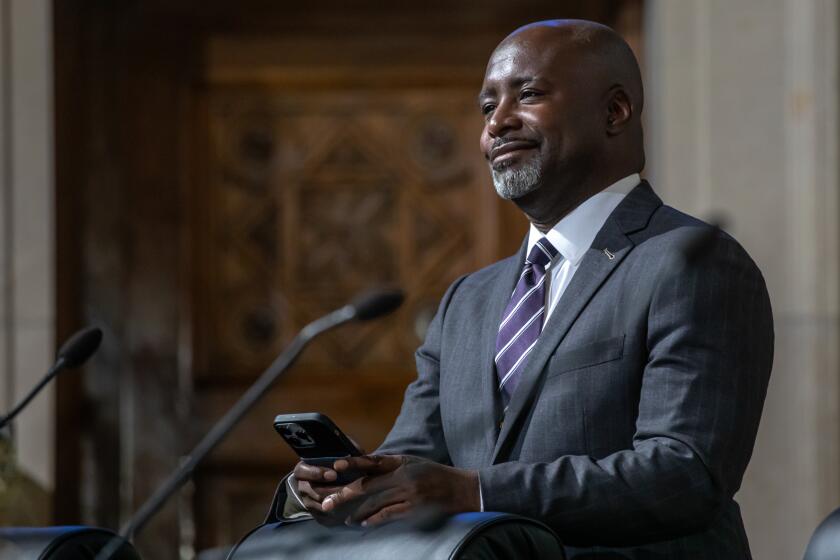Student Concern Helped to Oust Leader at CSUN Center for Deaf
- Share via
This school year began as many others have at the widely respected National Center on Deafness at California State University, Northridge. In January, a new class of young professionals traveling from across the country and as far away as Australia arrived at the center to enroll in its master’s degree program.
The 1985 class was different from previous ones. Almost immediately they sized up the center’s academic program, the National Leadership Training Program, as overrated and behind the times, although it was the first of its kind in the country.
“It’s obvious it’s been watered down,” said Beth Schreiber, a member of the 1985 class, who recalled that some of the classes and activities “seemed like finger painting.”
“Not only did they water it down, they lost the quality,” she said.
Class members were so dissatisfied with the eight-month program that they wrote a 22-page letter outlining what they perceived to be the weaknesses and how the program could be changed to be more relevant.
Many Awards Earned
That letter turned into a knockout blow for Ray Jones, longtime director of the center and the training program, which is one of the center’s main features. As a CSUN professor, Jones helped develop the training program and for about 20 years has been showered with national and international awards for his achievements in the field of deafness.
Concluding that the program “had fallen apart,” in the words of Donald Cameron, associate vice president of faculty affairs, the university earlier this month ordered Jones to relinquish his position and reassigned him to the department of educational administration, supervision and higher education.
The action was not completely unexpected. CSUN’s administration had been concerned about the quality of the program for several years and had received complaints from students in past years, although never as many as in 1985, Cameron said.
In hopes of strengthening the program, he said, two years ago the university made James Johnstone, chairman of the educational administration, supervision and higher education department, a co-director of the program.
The university was dismayed when it learned recently that the federal government would not give the training program funds for the 1986-87 school year. Of 10 universities that applied for grant money, CSUN’s proposal was ranked ninth in merit. In the past two years, the center had received about $80,000 in federal funds for the program.
Success--not controversy--is what the National Leadership Training Program has always been known for. The program was created to provide exposure to the latest developments in the field of deafness for administrators and would-be administrators at schools and social agencies that work with the deaf.
The center’s walls are crowded with success stories. Colored index cards, each bearing a graduate’s photograph, list the job each participant had before his stay at CSUN and what he has achieved. It has been said that the photo gallery represents a who’s who of deaf educators in the United States and in some other parts of the world.
‘I’m in My Prime’
Jones’ exodus has sparked a discussion among university staffers and the deaf community over what went wrong with the training program. Not everyone blames Jones, who insists that the university made a big mistake by removing him from the program.
“I think I’m really in my prime in administration,” said Jones, 68. “This is the best time in my life to make contributions in the field.”
One of Jones’ academic supporters is Johnstone. Johnstone conceded that the center and the training program “were losing their influence,” but, he said, “I just hope the reassignment of Dr. Jones will not interfere with the programs we offer because I think they are excellent and provide a needed service to the community.”
Critics, however, said that, in recent years, Jones no longer was an innovator.
“In the last few years, things have not really been the same,” said Herb Larson, the center’s deaf director of support services. “The deaf community was very upset with us because we didn’t have the same involvement with the deaf community. There seemed to be a lack of interest in keeping the same standards.”
Concentrated on Funding
Jones acknowledged that, as director, he had not been as active within the deaf community in Los Angeles in recent years because of family considerations and because he was concentrating on getting federal funding for construction of a new facility. Jones said he is proud that the center has raised $2 million toward that goal in recent years.
The current facility is housed near the CSUN student center in three prefabricated bungalows that were meant to be temporary but became permanent over the years.
According to student Schreiber, many of the training program’s classes were not substantial and three courses did not have professors for the first three weeks. When one class finally got an instructor, she apparently had not been told what the course, “Law and the Handicapped,” was about, Schreiber said. She said other professors did not realize that they were teaching specialized classes and had no idea what the National Leadership Training Program was.
“I think they need to rethink what they mean by National Leadership Training Program,” said Phil Harper, a youth worker from Australia who graduated in August.
Curriculum Outdated
“I think a major complaint, and a valid one, is that the curriculum has not changed enough over the years to take into account the changes in the field,” Vice President Cameron said when asked about the students’ complaints. “They believe quite rightly we are assigning them classes on campus that were assigned 10 years ago. . . . They were thrust into classes that we had in our catalogue that weren’t aimed toward them.”
Jones, however, insists that he wanted to make the training program more relevant but was stymied by CSUN’s administration. For that reason, he said, he decided to leave the training program before the 1985 session, although he remained as director of the National Center for Deafness.
Johnstone, who said he had no experience in deaf education, said Jones served as an adviser for the 1985 class and helped determine program goals and class offerings.
The university is planning to launch a nationwide search soon to replace Jones.
“People are anxious to see what will happen,” Larson said. “I think they are looking forward to the change and I think the change will be a good one.”
More to Read
Sign up for Essential California
The most important California stories and recommendations in your inbox every morning.
You may occasionally receive promotional content from the Los Angeles Times.










